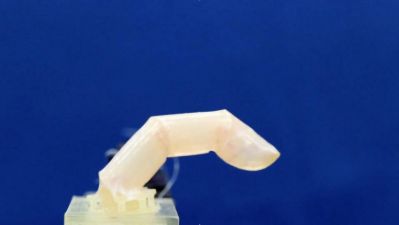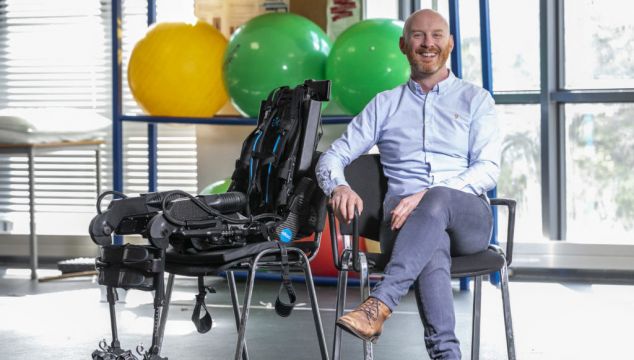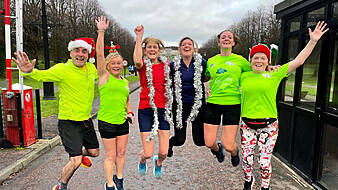An Irish university backed programme is hoping to be one of the first in Europe to give children in wheelchairs the experience of walking again in a new paediatric robotic exoskeleton
The exoskeleton programme in Dublin City University (DCU) has already helped over 100 adults and now aims to support children who are using wheelchairs due to neurological disorders.
Those who have donned the adult suit recently include Liverpool fan and Meath resident Sean Cox who was left with life changing injuries after an unprovoked attack outside Anfield.
Now physiotherapist and clinical lead of the exoskeleton programme Ronan Langan is hoping to source donors to fund the operational costs of the suit which itself costs €180,000.
The 12kg Atlas 2030 paediatric exoskeleton is specially designed for children between three and 14 years old and supports the child from the trunk to the feet
It fits around the child's legs and torso and the joints contain a series of small but powerful motors which then mimic the muscle movements of the child.
"We are just back from Madrid where the first company in the world has started making paediatric suits for children from the age of three years old," he said.
"They have only sold 30 so far worldwide, with a handful in Europe, most of which are in Spain with support from the Spanish Health Service
"The suit helps achieve quickly the rehabilitation goals that would take months to achieve with conventional therapies, such as strengthening muscles and improving patients' digestive and pulmonary systems as well as boosting morale
"The suit may help to keep some kids with worsening mobility on their feet, or help a child rehabilitating after an accident to get back walking better, It will be different for all, including some that just get the chance to walk in the suit."
Ronan believes the suit could help reduce the need for surgery for those with neuromuscular scoliosis
The specialised suit could be used on children with spinal issues before they go through developmental stages and could help stop the curvature of the spine. Neuromuscular scoliosis is the second most common form of the condition
"It will help children to walk who are suffering from spinal injuries and conditions such as Spina Bifida or spinal muscular atrophy, which cause scoliosis."
The exoskeleton programme in DCU is a physiotherapist led service allowing people with reduced mobility to complete sessions of supported walking in the suit.
The programme is designed to deliver an array of benefits that regular walking in an exoskeleton provides for persons with spinal cord injury, stroke, multiple sclerosis and other neurological conditions
In adults, being upright in the €200,000 suit can alleviate additional health problems caused by being in a wheelchair. It can help circulation, bowel and bladder function and ease pressure sores and urinary tract infections
The former senior physiotherapist in spinal cord injury system of care at the National Rehabilitation Hospital has been heading up the DCU research unit since 2019
"The suit costs in the region of €200,000 to fund and run for up to six years, and we have a five to six month waiting list for applicants
"The suit doesn't just help with spinal cord injuries but benefits stroke victims or those with Multiple Sclerosis or brain injuries - anyone who has a mobility impairment.
"After the initial assessment, we try to create ongoing access for people and dozens have made over 25 walks each so far, which is terrific because there has been no research concluded worldwide on people that are this experienced at using this technology.
"After the initial wow factor, a full-time wheelchair user will see massive health benefits.

"We are trying to train family members as handlers so that they can have more access to the suit if we aren't available.
"Not all people will walk in the suit, it depends on when the injury happened. If it occurred when they were young, before their developmental stages, they may not be able to walk in the suit and that's why we screen all applicants.
"To be in the suit and upright for the first time in a long time can be really challenging on the body. People can feel like vomiting or fainting because their blood pressure drops suddenly.
"But when they get through that and find their balance and take a step, it's very emotional. I'm offered hugs a lot," he laughed.







